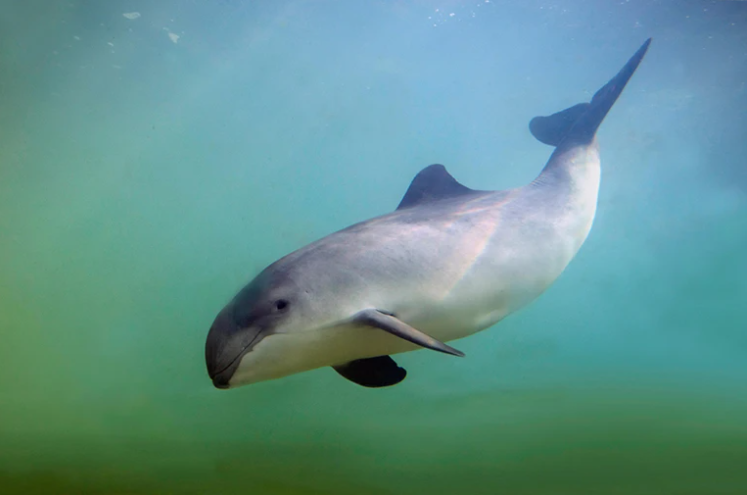
The harbour porpoise is among the species threatened by the Nord Stream blasts.Credit: Minden Pictures/Alamy
The explosions that blasted holes in the underwater Nord Stream gas pipelines kicked up long-buried toxins at levels high enough to threaten marine life for more than a month, analysis of the site suggests.
Last September, a series of four explosions ruptured the Nord Stream 1 and 2 gas pipelines — which run from Russia to Germany — close to the Danish island of Bornholm in the Baltic Sea, releasing more than 100,000 tonnes of methane into the sea and the atmosphere. It isn’t clear who was behind the explosions, but the most recent speculation is that a pro-Ukrainian group was responsible.
Beneath the dramatic sight of bubbles belching from the sea, the explosions also threw up sediment from the sea bed, returning it to the water column. A team of environmental scientists, led by Hans Sanderson at Aarhus University in Denmark, were concerned that the consequences not be overlooked, particularly considering that the blasts happened in the vicinity of a historical dumping ground for chemical warfare, including mustard and arsenic agents from the Second World War. They scrambled to work out how these chemicals might affect marine life.
Blast impact
The researchers used decades of monitoring data of the sediment in the busy shipping area of the Bornholm Basin, and hydrological models of sediment transport, to work out the impact of the blasts, each of which is estimated to have been equivalent in power to the explosion of 500 kilograms of TNT. Their models showed that the explosions, which happened at about 70 metres deep, threw up a total of 250,000 tonnes of sediment, which reached up to 30 metres below sea level. Sanderson and his colleagues took the known concentrations of various contaminants in the sediment, including the biocide tributyltin (TBT), heavy metals and the chemical-warfare agents, to see what was being stirred up.
They worked out how much of each contaminant would become bioavailable and calculated a toxicity threshold for the sediment. Any more than 5.8 milligrams of sediment re-suspended per litre of seawater was predicted to be harmful to marine life. The team found that the contaminants in the sediment, including lead and TBT — an endocrine disrupter used to protect ship hulls — accounted for most of the toxicity. Lead and TBT alone were responsible for 75% of the toxicity.
The sediment thrown up by the Nord Stream 1 blast contained contaminants that breached the threshold safety level for 15 days, at depths of between 95 and 53 metres. For the Nord Stream 2 pipeline, the threshold was breached for 34 days, at depths of between 78 and 42 metres. In total, the blasts contaminated 11 cubic kilometres of seawater for more than a month. The work, which is under peer review at a journal, has been published as a preprint1.
‘Impressive modelling’
“It’s an impressive modelling exercise,” says Rodney Forster, a marine scientist at the University of Hull, UK. And the teams’ calculations of the sediment plume’s dispersion show clearly that the sediment didn’t reach the sea surface. “That explains why, apart from the bubble plume, no visible suspended sediment plume can be seen in satellite images after the event,” Forster adds.
The contaminants’ impact on marine life won’t be known definitively for months, if not years. But Sanderson is concerned about some of the region’s animals. The area is a known cod-spawning site. “There are high concentrations for a long duration in a large area,” he says of the contaminated sediment. “It could potentially have a quite significant impact” on cod stock. And the presence of TBT is “not good news for these organisms”, he says. The blasts happened at the end of the cod-spawning season, and the eggs float at depths that the stirred-up sediment reached. Sanderson speculates that the physical weight of the sediment could be another problem for the eggs, weighing them down so that they no longer float at the optimal depth to thrive before they hatch.
Other animals potentially affected include the harbour porpoise, of which there are estimated to be only 500 left in the Baltic Sea. The loss of even one would affect this population. It is possible that the blasts damaged the porpoises’ hearing, and so their ability to communicate.
Sanderson says that the team’s research shows that sediment content needs to be addressed alongside any activity that stirs up the sea bed — such as installing pipelines or wind turbines, or fishing. “There are also environmental impacts of conflicts and these also need to be clarified,” he adds.
doi: https://doi.org/10.1038/d41586-023-00746-2
References
Sanderson, H. et al. Preprint at Research Square https://doi.org/10.21203/rs.3.rs-2564820/v1 (2023).